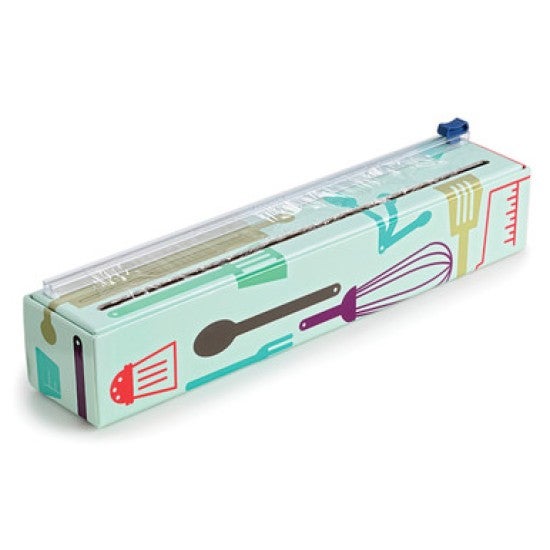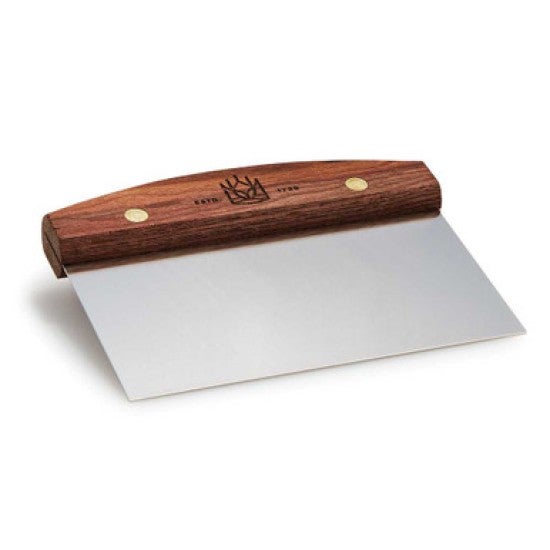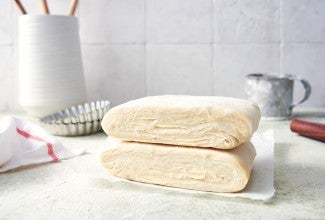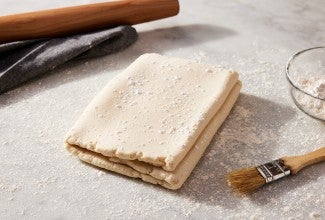-
To make the dough: Put the eggs and water in a large mixing bowl. Add 1 tablespoon of the sugar, 3 cups (362g) of the flour, and the yeast. Mix until well blended; set aside to let the sponge work.
-
To make the butter block: Cut the butter into 1" chunks and combine with the salt and flour at low speed in a stand mixer fitted with the paddle attachment just until smooth, with no lumps. Be careful not to beat too much; you don’t want to incorporate any air.
-
Spread the butter on a piece of plastic wrap and shape into an 8˝ square. Wrap and refrigerate for 30 minutes.
-
To finish the dough: Add the melted butter to the sponge. Whisk together the remaining sugar, 2 1/2 cups (298g) of the flour, the dry milk, and salt and add to the sponge. Mix until the dough forms. Knead for 5 minutes; touch the dough lightly with your finger. If it’s still sticky, add the remaining flour 2 tablespoons at a time until the dough is the desired consistency. Once the dough is smooth and elastic, pat it into a 9˝ square, then wrap and refrigerate for 30 minutes.
-
To laminate the dough: Remove the chilled dough from the refrigerator and gently roll it to a 12" square.
-
Unwrap the butter square and place it in the center of the dough at a 45° angle, so it looks like a diamond in a square. Pull the corners of the dough into the center of the butter diamond. Moisten the edges with a little water and pinch the seams together well to enclose the butter. Dust the top with flour and turn the packet over.
-
Tap the dough all over with a rolling pin, encouraging it into a rectangular shape. Once it’s pliable, roll it to a 20˝ x 10˝ rectangle, picking it up and dusting lightly with flour as needed.
-
When you’ve reached the proper size, use a dry brush to sweep off any excess flour and fold the dough in thirds, like a business letter. Take care to keep the edges straight and line them up directly over each other. If the dough slides around, use a little water at the corners to tack them in place. This is your first turn.
-
Rotate the dough out so it looks like a book about to be opened. Roll the dough out once more to 20˝ x 10˝ and fold it as before. This is the second turn. Wrap the dough and refrigerate it for 30 minutes to allow the gluten in the dough to relax.
-
Give the dough two more turns after its rest, then wrap the dough well and refrigerate for at least 1 hour or overnight before using. You can also freeze the dough at this point.
-
To shape the croissants: Cut the packet of dough in half. Wrap and refrigerate or freeze one half.
-
Roll the other half to a 13" x 18" rectangle. Trim the edges about 1/4" all the way around with a ruler and pizza cutter. This removes the folded edges that would inhibit the dough’s rise.
-
Cut the dough in thirds lengthwise and in half down the center. This will give you six 4" x 9" pieces. Cut these pieces in half diagonally and arrange them so the points are facing away from you. Stretch them gently to make them a little longer, then cut a 1" notch in the center of the base of each triangle.
-
Take the two inside corners of the notch and roll them up toward you, building a curved shape as you roll the base of the dough toward the tip. Make sure the tip ends up under the bottom of the croissant. Place the shaped pastry on a parchment-lined baking sheet, curving the ends toward each other. Refrigerate for 30 minutes.
-
Take the croissants out of the refrigerator, and let them warm and rise for 60 to 90 minutes at room temperature. They should expand noticeably, and when you gently press one with your finger, the indentation should remain.
-
Towards the end of the rise time, preheat the oven to 425°F. Brush each croissant with an egg beaten with 1 tablespoon water. Bake for 15 minutes, then reduce the oven’s temperature to 350°F and bake for 10 to 15 minutes more, until deep golden brown and no raw dough is visible where the layers overlap. Remove from the oven and let cool on the pan on a rack for 20 minutes before serving.




















